« January 2011 | Main | March 2011 »
February 27, 2011
Coffee Break

Douglas Sirk in From UFA to Hollywood: Douglas Sirk Remembers (Eckhart Schmidt - 1991)
Posted by Peter Nellhaus at 08:11 AM | Comments (1)
February 25, 2011
From the Thai Film Foundation: Sugar is not Sweet

Nam Tan mai warn
Rattana Pestonji - 1965
Some films are a challenge to discuss because they seem to take place not only in a different country or different time, but in a different universe. in terms of most conventions regarding narrative film, Sugar is not Sweet is almost like a collection of scenes that meanders along to its happy ending. A more coherent film could have been made by jettisoning several musical numbers and other bits of business that seem to pad out the running time to two hours. What makes Rattana Pestonji's last film interesting to watch are some of the various parts, even if they don't add up to whole film.
The story, such as it is, is about the businessman, Chaokun, who has made his millions from selling a hair restorative product. The product was originally the idea of his late friend, Boong, an Indian. Chaokun decides the best way to show his appreciation to Boong, is to have his playboy son, Manas, marry Boong's daughter, Sugar (Nam Tan). Manas would rather spend his time with the sultry Watchari, who happens to have a boyfriend on the side. Chaokun convinces Manas to marry Sugar with an offer of two million baht if the pair gets married, an offer raised to five million if the two produce a grandchild. Manas and Sugar take turns humiliating each other, with Manas temporarily locked up in a psychiatric hospital. Manas finally gets the upper hand on Sugar, who has steadfastly refused to go to bed with her husband, by playing on her fear of gekkos, those friendly lizards often found in Thai houses. (For myself, there was a cute little green one in my Chiang Mai condo that hung around the kitchen that I treated to tiny bits of food.)

Among the highlights was the comic performance of Chaokun's right hand man, Moti, with his cackling laugh and his Chaplinesque stroll with his cane. Also, the use of color is astounding, with the most intense pastels on the screen. Even when one isn't sure what to make of Pestonji's ideas about character motivation or logic, there is always the unusual colors of the walls and clothing to admire. In one scene, Manas sings a song in the dark, sitting by a blue tinted tree. The use of color can be seen as an inspiration for the imaginative use of color by Wisit Sasanatieng in Citizen Dog.
What may well catch western audiences off guard are the displays how some Thais view non-Thais. Manas initially objects to marrying a woman who is not Thai, and Sugar is often referred to as a "Roti", the name of the Indian flat bread. Sugar is first welcomed to Thailand with a mock Bollywood dance performance where she is almost smothered in garlands. In a couple of scenes, Chinese and Vietnamese gibberish is spoken. I would suspect that even though he was born in Thailand, being of Iranian descent may have contributed to Pestonji's feelings of being something of an outsider in his own country.
Of the cast, the best known actor is Sombat Metanee as Manas, a leading star of the Sixties and Seventies, still active in supporting roles, and perhaps best known currently as the chief villain in Tears of the Black Tiger. Somphong Phongmitr is the scene stealing Moti. As the voluptuous Watchari, Preeya Rungruang could well inspire a search for her other films, subtitles or not, by dint of her scene in the shower. In a small role as a television pitchman is future director Ruj Ronaphop. Unknown to me is the name of the Thai combo that performs at the wedding party of Manas and Sugar, fronted by what appears to an American woman named Roger (?), though their cover version of Fats Domino's "I'm Walkin"" ain't bad.
Sugar is not Sweet can be viewed online at Asia Pacific Films.

Posted by Peter Nellhaus at 08:08 AM
February 23, 2011
Iranian Film blogathon

Some might find it odd, but it was my mother, at that time a resident of Jerusalem, and a fervent Zionist, who encouraged me to see my first Iranian film. That film happened to be Gabbeh by Mohsen Makhmalbaf. The film is mostly about a young woman and a rug, a specific kind of Persian rug. There's more to the film than that, but I've been watching Iranian films since then.
I made a point of sending by niece a DVD of Jafar Panahi's Offside for two reasons. First, I thought it important that as a teenage girl that she sees a film with strong, positive, female characters around her age. Second, I wanted to give her some glimpse into Iran and Iranians that would counter the usual impression provided by U.S. mass media. Third, I wanted to let her know that there are sometimes worthwhile films that don't show up at the neighborhood multiplex.
For myself, just because I don't write about Iranian films doesn't mean I don't watch them. I do have a couple of posts from years back with links provided here. One is for two films written by Abbas Kiarostami, one directed by Kiarostami and the other directed by Jafar Panahi. This was posted back when this blog was still in its infancy, when my skills at HTML were more primitive than they are now, and before I learned how to add screen caps.
The second posting is about a book and a DVD that look back at the history of filmmaking in Iran. While there is some kind of sense about Iranian film from about the late 1990s on, there is only an extremely limited amount of material letting us know of the films and filmmakers from earlier eras.
For much more on Iranian cinema, please visit the blogathon home site at The Sheila Variations.
Posted by Peter Nellhaus at 05:43 AM | Comments (1)
February 21, 2011
Sleepy Eyes of Death - Collector's Set Volume 2

Sleepy Eyes of Death 5: Sword of Fire/Nemuri Kyoshiro Enjyoken
Kenji Misumi - 1965

Sleepy Eyes of Death 6: Sword of Satan/Nemuri Kyoshiro Mashoken
Kimiyoshi Masuda - 1965
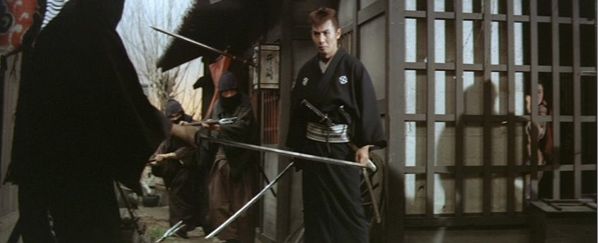
Sleepy Eyes of Death 7: The Mask of the Princess/Nemuri Kyoshiro Tajyoken
Akira Inoue - 1966
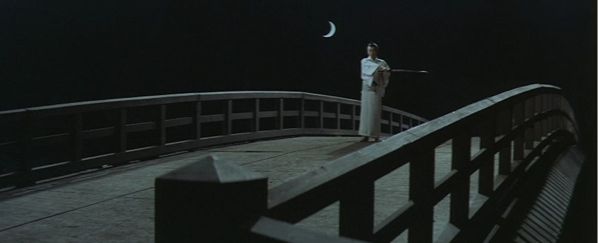
Sleepy Eyes of Death 8: Sword of Villainy/Nemuri Kyoshiro Buraiken
Kenji Misumi - 1966
AnimEigo Region 1 DVD
It's been about a year and a half since the first set of four films came out on DVD. Hopefully, fans of this series won't have to wait quite so long for the final four films. Even though one of the films contains a character from one of the earlier films, all can be enjoyed as stand alone entertainment. The basic template is that Kyoshiro Nemuri is a ronin, a masterless samurai, who wanders from place to place, only to find himself caught up in some kind of intrigue revolving around the ruling families. Young and handsome, woman fling themselves at him, whether they be courtesans, princesses or even nuns. The men know of Nemuri by his reputation, his sword technique called the Full Moon Cut.
Two of the films in this set were directed by Kenji Misumi, whom I've discussed in other postings. Misumi is best known for directing many of the best films in the original Zatoichi series, Of the two films here, the fifth entry in this series is the best. Even more amazing when one considers that Misumi was cranking out three or four movies per year, Sword of Fire is worth watching simply for its formal beauty. Lots of framing devices are employed here, be they shoji screens, windows, or branches.

Nemuri gets caught up by protecting a woman, Nui, from being attacked by another swordsman. The story involves a conspiracy to murder a band of pirates, stolen treasure, a woman with a unique tattoo, and some illegal schemes to make a lot of money. What makes watching the relationship between Nemuri and the villainous Nui even more interesting is knowing that Nui is played by the star of the Zatoichi films, Shintaro Katsu's wife, Tamao Nakamura.

A female nemesis, played by Michiko Saga, is the best part of watching Sword of Satan. Saga plays the part of Orin, a woman determined to avenge the death of her brother, flinging sharp metal squares at Nemuri. The story involves the kidnapping of a young boy, who was to be killed as an infant because of his birth meant being the heir to a clan family, only to be held hostage because his existence allows the clan to continue to receive patronage from the shogun. The film is about 75 minutes long, and while it doesn't have the artistic aspirations of Misumi's work, director Kimiyoshi Yasuda lets the action zip along, with just enough time for shots of geysers of blood and a large body count in the sword fighting scenes. One of the first characters in this film is a woman, a would be prostitute, who wears a Noh mask when first scene. Various shots of the mask provide a form of visual refrain.
A Noh mask also figures in the appropriately titled Mask of a Princess. Akira Inoue's film brings back the character of Princess Kiku from the fourth film. Kiku wears the mask to hide the half of her face burned and badly scarred. Kiku seeks to kill Nemuri because he is the only man to have seen her unmasked, although like every other woman in the series, she has feelings of unrequited love. There is also a stranger that Nemuri meets by chance who shows intense interest in Nemuri's sword technique. As if dealing with the stranger and Kiku's band of ninjas wasn't enough, Nemuri also decides to pay off the debt of a samurai hating maid, Haru, who disguises any appreciation with a perpetual pout. One of the highlights involves Nemuri going to bed with a nun who decides that bearing an heir is more important than keeping vows of chastity, with our hero waking up to a couple of deadly snakes.
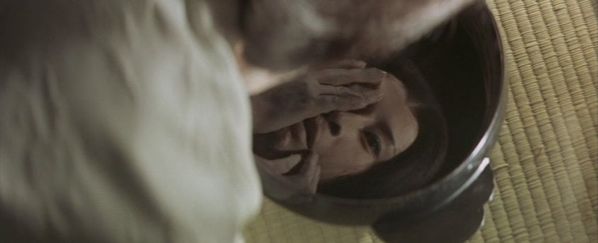
Misumi returns to direct Sword of Villainy. This time there is a conspiracy involving the distillation of some flammable water, to be used for lighting lamps, stolen plans, and a broken promise to use profits to feed the poor citizens of Edo, present day Tokyo. The story is a fictionalized version of one of the several massive fires that virtually destroyed the entire city. Among the characters are some gymnastic performers, including a young woman who is out to seek revenge for being used by one of the conspirators. Shiho Fujimura may not have been the prettiest actress at the Daiei Studios lot, but she was game enough for a scene where she needs to flee two dueling swordsmen, taking a flying and nude jump into a nearby river.
As indicated by these films, the Sleepy Eyes of Death series has established certain patterns. The main character of Kiyoshiro Nemuri is unusual as a ronin, with his outsider status double confirmed by being biracial, the son of a European, a missionary turned apostate. Even though Nemuri does not identify himself as Christian, and keep in mind that the films take place when being Christian in Japan was illegal, the films occasionally have references or scenes revolving around Christianity or more luridly, Black Masses. On a lighter note, the series also includes a scene or two of eye candy of the type that would have been quite racy for American audiences back in the mid Sixties. As is the case for AnimEigo's DVDs, there are extremely readable, colored subtitles, and additional notes that provide more historical context for each film. Knowing that Shiho Fujimura returns in the twelfth, and final, Kiyoshiro Nemuri film is enough incentive for me to see this series through the end.
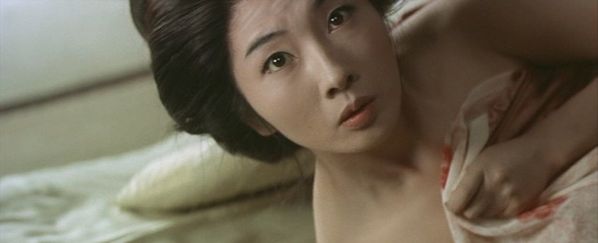
Posted by Peter Nellhaus at 08:25 AM
February 20, 2011
Coffee Break
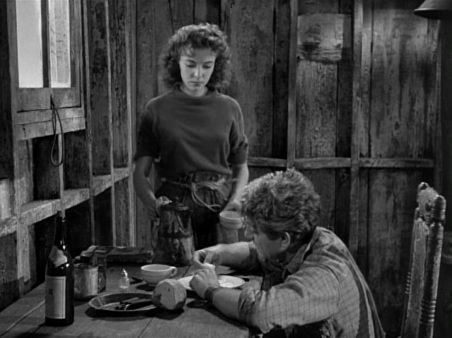
Ida Lupino and Jean Gabin in Moontide (Archie Mayo - 1942)
Posted by Peter Nellhaus at 08:26 AM
February 19, 2011
Coffee Break

Ray Collins (back to camera) and Robert Mitchum in The Racket (John Cromwell - 1951)
Posted by Peter Nellhaus at 08:45 AM
February 18, 2011
For the Love of Film (Noir): The Equation of Love and Death

Li Mi de caixiang
Cao Baoping - 2008
Tai Seng Entertainment All Region DVD
Cao Baoping's movie about a taxi driver might not be true film noir in the classic sense, but there is enough mystery and emotional darkness for consideration here. The title translated from Chinese is "Li Mi's Guesses". Like any reasonably good mystery, the audience is kept guessing as well, until clues and connections are more fully revealed. Unlike the classic noir with its occasional infinite blackness and long shadows, The Equation of Love and Death takes place in daytime suffused in bluish gray.
The constantly smoking Li Mi is obsessed with the four years that she has not seen her boyfriend, Fang Wen. Counted are the number of letters received, days between letters and the days since Fang Wen had last written to her. Passengers are the unwitting as well as unwilling recipients of Li Mi's constant obsession, listening to her various theories and attempts to create a logic out of the numbers of days, weeks and months during that four year period.

The film takes place mostly in Kunming, a major city in southwestern China. Li Mi picks up two men who appear to be out of place in an urban environment. Trouble begins when Li Mi is forced to leave her cab to get change for her passengers. What appears to be a minor inconvenience for the driver and passengers escalates to a more dangerous situation for all involved. Cao cuts between several characters who at first appear to be accidentally connected. What gradually unfolds is both a story of lost love, and of people so desperate for money that they turn to crime for quick financial gain, only to lose everything in the process.
Just as Li Mi is propelled by the memory of Wang Fen, one of the passengers, Shuitian, is convinced that his lost love is somewhere in Kunming. The open faced, smiling Shuitian keeps his dream in spite of all that happens to him. Li Mi eventually discovers the truth about Wang Fen, much to her dismay. In a sense, one could view The Equation of Love and Death as a variation on the story of the destruction of youthful dreams of people from rural environments colliding with the alienation and ultimate loneliness of life in the big city. Shuitian's missing girlfriend ran away from home rather than work as a prostitute at the behest of her mother, a woman who convinces Shuitian that his worthiness would be based on coming home with a large sum of money. Like many classic noir films, money, if not necessarily the root of evil, is often the source of trouble, if not outright corruption.
For most critics, the film belongs to star Zhou Xun, who won the Asian Film Award for her performance as Li Mi. Zhou also starred in another film that could be described as Chinese noir, Lou Ye's Suzhou River. There are some shared qualities to both films, both about love and illusion, and both very much worth seeing. Zhou has been noted as being cast against type, playing a working class woman in drab clothing, although even with no makeup, her freckles often visible, she is still remarkably pretty. The Equation of Love and Death is Cao Baoping's second feature. There is very little in English about Cao, although one article notes his interest in presenting a more realistic look at contemporary Chinese life. Cao participated in a screenwriting workshop at Sundance last year, with a film also centered on a strong female character, hopefully an indication that more of significance will be heard from this filmmaker in the near future.

More love and death can be found at Ferdy on Film and Self-Styled Siren. The equation of adding your generous donation for helping preserve the classic film, The Sound of Fury, with this special blogathon link, a joint project with The Film Noir Foundation is what this blogathon is all about.
Posted by Peter Nellhaus at 09:39 AM
February 17, 2011
For the Love of Film (Noir): A Bittersweet Life

Dalkomhan insaeng
Kim Ji-woon - 2005
Jin Sun Media All Region DVD
Coming in between the attention grabbing A Tale of Two Sisters and the crowd pleasing The Good, The Bad and The Weird, I can't understand why A Bittersweet Life has no U.S. distribution in any format. There are some cultural nuances, to be sure, but nothing that would make this film difficult to understand. What makes Kim a filmmaker of interest is his jumping from genre to genre successfully.
The basic story is classic film noir about a mob boss, his girlfriend, and the trusted right-hand guy who's been asked to look after the girlfriend. Just a glimpse of a woman's legs is enough to signal that things are going to turn out badly for everyone. Sun-woo works as a hotel manager, and also enforcer for the gangster Kang. Before leaving for a business trip, Kang asks Sun-woo to look after Kang's young girlfriend, Hee-soo. Kang suspects Hee-soo of seeing someone else. Sun-woo meets with Hee-soo on behalf of Kang, and also follows her secretly at night. Meanwhile, the forcible ejection of a trio from a rival gang from the hotel escalates to a point where Sun-woo is the target of both the rival gang and Kang's team. Even if the story about shifting loyalties and revenge seems familiar, it is in the way Kim shapes the story that makes it unique.

Kim is something of a visual virtuoso such as the series of traveling shots through the corridors of the hotel. In one scene, members of the rival gang beat up Sun-woo in his own apartment, a scene made more kinetic with lit shots alternating with blackness, continuing a visual pattern of Kim lying on his couch, mindlessly flicking his lamp on and off. In another scene, Sun-woo fights off members of his own gang, getting hold of a car which he uses as a means both of attack and escape. There is a Spanish flavor to the music used, as if what we are watching is a bull fight, with Sun-woo as the angry bull.
In an interview with Paolo Bertolin, Kim discusses this film as his version of Film Noir: "I just wanted to explore the noir genre, tell the story of this character, and tackle the themes that you see in it. By bringing together these needs, the end result is something quite different from anything I have done before. Yet such an outcome is not due to my choosing for a departure, but just to the necessity of finding a style that better suited the genre and storytelling specificities."
Where Kim's film is most like Film Noir is that the lead character is a solitary figure whose only satisfaction appears to be in doing his work. Before leaving for Shanghai, Kang asks Sun-woo if he has a girlfriend, or has even fallen in love. Like many classic noir films, the man's life is irrevocably upended when he meets "the girl". What is different here is that Sun-woo's feelings for Hee-soo remain unstated until near the very end, in a very indirect manner. What is most similar to classic noir is that the character of Sun-woo, like many noir protagonists, finds himself in a situation that he ultimately has no control over, that becomes increasingly chaotic and violent. With posh settings and facades of corporate respectability, A Bittersweet Life made me think of the iconic neo-Noir, Point Blank, particularly when Sun-woo, like Walker, seems to come back from the dead to get even with all who have wronged him.

More bitter and sweet Film Noir is to be found at Ferdy on Film and Self-Styled Siren. Definitely sweet are contributions made to the blogathon link for saving the classic The Sound of Fury, in conjunction with The Film Noir Foundation.
Posted by Peter Nellhaus at 08:00 AM | Comments (2)
February 16, 2011
Coffee Break
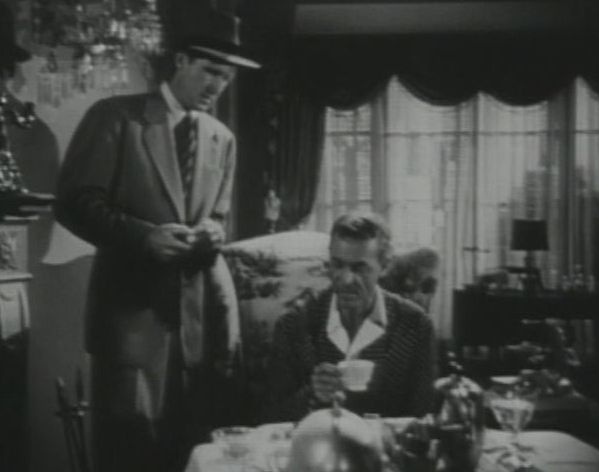
Lloyd Bridges and John Hoyt in Trapped (Richard Fleischer - 1949)
As you can see, Lloyd Bridges is trapped alright, in a crummy DVD. It may be too late to save this estimable actor in one of his early starring roles here, where he plays a counterfeiter who thinks he knows all the angles. Ferdy on Film and Self-Styled Siren, along with myself hope you can forward some real cash to this blogathon link on behalf of preserving The Sound of Fury, a legal joint with The Film Noir Foundation.
Posted by Peter Nellhaus at 08:50 AM
February 15, 2011
For the Love of Film (Noir)(Giallo): Footprints
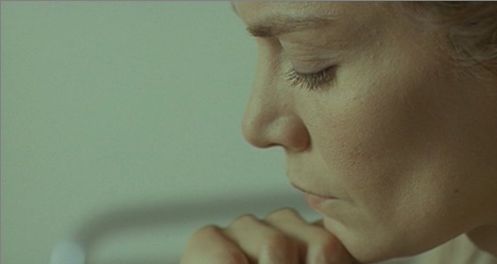
Le Orme
Luigi Bazzoni - 1975
Shameless Entertainment Region 0 DVD
On the occasion of Florinda Bolkan's 70th birthday.
While focussing on film noir and film preservation, I don't find it inappropriate to take a look at film noir's younger, colorful, and sometimes flamboyant sibling, giallo. Giallo filmmakers, most clearly Dario Argento, have been inspired by film noir, noticeable in the casting of actors associated with some of the classics of the past. Giallo also was the result of the dissolution of the old Hollywood production code, with the new films revealing what the older films mostly concealed. Again, we can thank the British DVD label for rescuing a film that might have be lost, or at least not available in its most complete version. Whether Footpriints is truly an important film doesn't matter. Consider the years it took before there was universal acclaim for Touch of Evil or The Big Combo.
Some of the story elements in Footprints could well be found in film noir. The main character waking up to find that three days of her life are missing, strangers who remember her as someone with a different name, and the recurring nightmare are to be found as parts of other films. In this case, it is a woman named Alice who dreams of an astronaut being abandoned on the moon, who discovers that the next morning is Thursday and not Tuesday, and tries to uncover a mystery after finding a ripped postcard depicting a hotel in some remote town. Unlike classic film noir, Alice finds herself in a situation where the clues reveal greater mysteries.
The first images in the film are of the moon, but most of the film seems to take place in an alien landscape. What is seen of Rome are imposing steel and glass buildings. Most of the film takes place in a town called Garma, actually a village in Turkey, with a very large, ornate hotel and mosques in the village. With the exception of one scene, there are few people to be seen. Even Alice's hotel room is oversized and sparsely furnished. Vittorio Storaro often films Florinda Bolkan in such away to emphasize her aloneness, the emptiness around her, physically and emotionally.

Footprints is not a giallo in the way of Luigi Bazzoni's best known film, The Fifth Cord. The emphasis here is on the mystery, not violent set pieces. It may be a nod to the genre's name that part of the film revolves around a blood stained yellow dress. What makes this film also uncharacteristic is the frequent absence of color, with Bolkan primarily wearing white clothing, often with the scenes taking place in rooms with white walls and furnishings. One of the other places that might be of importance is a memory of a white house.
The mystery is based on what Alice may more may not remember of the missing days, but also the dream of the moon. Is the dream something taken from a partially seen science fiction movie? Is this in any way connected with Alice's work as a translator, working for some kind of international agency with scientists discussing the inevitable end of human life due to multiple forms of pollution? As in some classic film noir, Alice's paranoia may not be quite imagined.
What is it about Florinda Bolkan that makes her so alluring? It's unusual enough that one of the most acclaimed Italian actresses of her era was Brazilian. Bolkan's beauty is severe with its sharp features, especially the penetrating eyes. Bolkan most notably worked with Luchino Visconti, Elio Petri and Vittorio De Sica, as well as two films with Lucio Fulci. There is something so right about Bolkan as Lola Montez in Richard Lester's Royal Flash. Florinda Bolkan, even during her peak period, was not conventionally attractive, yet whenever she's on the screen, it's impossible to look away. There's a sense of commitment to her roles that Bolkan forces even the most implausible scenario to be taken seriously.
Featured in a small role in Footprints is the real crazy guy of cinema, Klaus Kinski, who may be a scientist, or possibly an actor playing one. Lila Kedrova has a small part as one of the people in Garma who might know more about Alice, than Alice herself knows. Kedrova and Bolkan would be seen together again thirteen years later in Michael Hoffman's Some Girls, as the grandmother and mother, respectively, of the three most beautiful sisters in Montreal.
Some of the classic noir films have been centered on women in trouble, such as Whirlpool and My Name is Julia Ross, films that are about a woman's loss of memory and self-identity. For myself, regarding Footprints as an extension of film noir is made easier from this quote from Jeremy Butler: "The noir protagonist is alienated from a combustible, hostile world, driven by obsessions transcending morality and causality . . . . The obsessive noir protagonist is drawn into a destiny he cannot escape; he is impelled toward his fate by exterior forces beyond his power and interior forces beyond his control." In the case of Footprints, the noir protagonist is a woman wearing a yellow dress.

More Noir in all its colors are to be found at Ferdy on Film and Self-Styled Siren. And let your fingers do the walking to the blogathon link where you to can save a print, even if it's a foot or two of The Sound of Fury, stepping up to the plate with The Film Noir Foundation.
Posted by Peter Nellhaus at 06:40 AM | Comments (2)
February 14, 2011
For the Love of Film (Noir)/From the Thai Film Foundation: Black Silk

Prae Dum
Rattana Pestonji - 1961
Black Silk has been described as Thailand's first Film Noir. I think noir purists would object, although there are certainly some noir elements. Allowing the film the widest berth possible, Black Silk is closer to something like I Wake Up Screaming than Double Indemnity. There's a heroine in trouble, a slimy boyfriend, and his even slimier boss, a stabbing, some shootings, and a few musical numbers. The film was also considered good enough to play at the Berlin International Film Festival fifty years ago.
Prae is young widow who works as a weaver. A friend of her late husband, Tom, is a constant visitor, attempting to get her to leave the house. Prae has no interest in the nightclub where Tom works, more so with a sick baby to care for. Tom's boss, Sina, owes money to a gangster, Wan. Sina comes up with a half-baked plan to have Prae and Tom accompany him while he visits Wan, with Prae discovering that she's to pretend to be interested in buying some land from Wan. Things get out of hand with Sina and Tom killing Wan and Wan's nephew. From there the plot becomes even more convoluted with Sina pretending to be his dead twin brother, and Prae's baby getting kidnapped in order to guarantee Prae's silence about the murders.

The title refers to Prae's outfit. She is always dressed in black, except for her time in a Buddhist monastery where she is clad entirely in white. This is the film where everything comes together for Pestonji. Parts of the film that have no direct bearing on the narrative are of value as documents of what parts of Thailand looked like fifty years ago - the wats, the uncrowded streets, life along a river with its boats and houses, even a classical Thai dance performed at the nightclub. While the DVD is not perfect, there is a reasonably good preservation of the color and letterboxed wide screen "Hunanaman Scope".
Black Silk has been praised rightly for Pestonji's use of color, much of it in solid swatches of red, black, blue, and white. One shot that took my breath away was a short overhead shot of Tom, in his white shirt, entering his red car, which diagonally filled most of the frame. I couldn't do a screen shot of Tom's car, but here is a shot of Sina's car, an iridescent blue, or so it appears to me. There is something so peculiar about the color of the two featured cars making them more conspicuous against the dark exteriors.

If any single classic Thai film was to be made more available for western audiences, this would be the one. Don't go by me. Two of the biggest fans of Black Silk just happen to be among the most critically acclaimed contemporary Thai filmmakers. For Wisit Sasanatieng, "Prae Dum is the film that remains my single major influence. It's the crown jewel of all Thai cinema. It shows that Khun Ratana was not simply a master storyteller, but that he knew how to use colour, art direction and camera angles to create subtle nuances and charge the movie with strong emotions."
For Pen-Ek Ratanaruang: "If I could choose, I would love to remake Prae Dum. It is so, so, so atmospheric and film noir. The shot when the camera pans from the coffin to the pair of sandles on the floor still gives me a chill. That shot would have made Hitchcock proud."
As it stands, Pen-Ek is making his own version of contemporary noir with his newest film, Headshot. Don't scoff at his naming Pestonji with Hitchcock as mere name dropping. When both filmmakers were younger men, in 1937, it was the man later known as the "Master of Suspense" who gave a prize to the novice filmmaker considered the master of Thai cinema.
Black Silk can be viewed online at Asian Pacific Films.
More fashions in Noir can be found at Ferdy on Film and Self-Styled Siren. Green is the favored color for helping preserve the classic film The Sound of Fury with a special blogathon link, a joint project with The Film Noir Foundation.
Posted by Peter Nellhaus at 12:05 AM | Comments (5)
February 13, 2011
Coffee Break
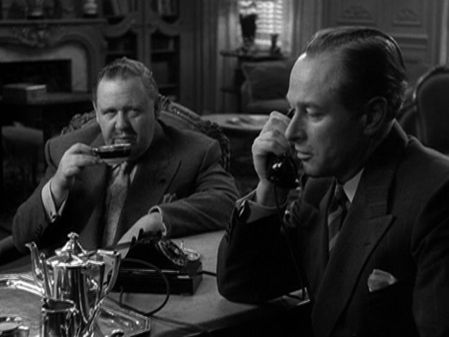
Charles Laughton and George Macready in The Big Clock (John Farrow - 1948)
Posted by Peter Nellhaus at 10:04 AM
February 10, 2011
From the Thai Film Foundation: Dark Heaven

Sawan Mued
Rattana Pestonji - 1958
Dark Heaven was Rattana Pestonji's first film in color. Sadly, given the state of film preservation in Thailand, while the film has been saved, the color is often faded. In an ideal situation, one would wish a digital picture and sound restoration.
Unofficially, this is also a Thai version of Seventh Heaven. The basic setup would be familiar to those who have seen either the Frank Borzage silent classic, or Henry King's sound remake. A hungry young girl, Nien, grabs some food from a small, street side vendor, food intended by the buyer, an obviously well-to-do older man, for a dog. Escaping from the man and the neighborhood policeman, Nien hides in the garbage wagon of Choo. Choo takes Nien under his wing, and the couple live together platonically in Choo's shack. Choo is called up for military service. Choo is blinded in battle.

Veering from the original story, Nien, disguised as a boy, takes Choo's job collecting garbage. Returning a dropped bracelet to a wealthy woman, Nien's disguise is undone, and the wealthy woman takes in Nien to live as her daughter. Pursued by a young, western educated doctor, Nien has her heart set on Choo. The doctor's proposed wedding is off when it is discovered that his father is the man who set the law on Nien for stealing food. Choo returns home, feeling that he has no future as a blind man. Nien reunites with Choo at his shack, her feelings of love unwavering. Contemporary audiences might find unintended humor when Choo attempts to commit suicide once it is revealed that the poison in the bottle is actually the only moderately less unhealthy MSG.
Pestonji's film is also a musical of sorts, with singing, but no dancing except for some very limited movement by Choo and Nien. There's even the old gag with Choo singing through a radio to indirectly express his feeling toward Nien. While taking a break from battle, Chool sings about Nien, with the other soldiers providing a chorus. There is very little written about Dark Heaven, but I would guess that while there isn't the kind of innovation with sound as was used in Country Hotel, Pestonji's aim was to again demonstrate there was a place for Thai films that employed the same technical know-how has in films from Hollywood.
At the same time, while Pestonji made films that differentiated himself from other Thai filmmakers, his films were made for a general Thai audience. The sympathies are with the garbage man, the street girl and even the cop on the beat. A more skeptical eye is cast towards the young doctor who makes a point of showing off his use of English in every conversation, and the doctor's father, who judges others by their apparent wealth. Pestonji may have also been looking for popular appeal with the casting of two popular singers, Sutape Wongkamheng as Choo, and Pensri Poomchoosri as Nien's benefactor. Nien was played by Seubneung Kanpai in her only movie role. Seubneung might not make anyone forget Janet Gaynor in one of her most famous roles, but she is sufficiently appealing to make this a lightly enjoyable film.
Dark Heaven can be viewed online at Asia Pacific Films.
Posted by Peter Nellhaus at 08:32 AM
February 08, 2011
From the Thai Film Foundation: Country Hotel

Rong ram Narok
Rattana Pestonji - 1957
Country Hotel is a one set wonder, a film that entertains in spite of a premise that defies any kind of logical explanation. The film takes place in a large bar, run by Noi, the self-described world champion arm wrestler. A variety of musicians including a Filipina singer and a Chinese Opera troupe seems to wonder in and out at random, performing a single number for the one or two other people who might be around. The hotel as such is misnamed as there is only one room, taken by a young man, Chana, whose desire for sleep is constantly thwarted. A young women, Riam, shows up, and settles for a the bar's couch when Chana refuses to give up his presumably comfortable bed. An attractive young woman of mystery, Riam insists that she's actually 65 years old, a divorcee with twelve children, and an opium trader. One of the recurring verbal jokes is about the name of the hotel. The hotel is called the "Paradise Hotel". Chana calls it "Hotel Hell", which is actually the translation of the Thai title.
I also suspect that one of the best sight gags was inspired by Preston Sturges' Sullivan's Travels. Prominently displayed in the bar is a giant picture of Noi, announcing two to one odds in his favor as world arm wrestling champion. How good is Noi? He is nonchalantly yawning, casually defeating one challenger after the other. One angry loser hits the portrait, changing the facial expression of the pictured Noi. Correcting the newly distorted mouth, Noi closely hammers at the portrait restoring it to its former glory.

About halfway through the two hour plus running time, the film shifts into a compact version of The Petrified Forest with the two hotel guests, Noi, and his uncle all held prisoners by a trio of thugs who've shown up to steal a company payroll. Tensions erupt between the gang members overnight. There's also a final showdown with a legendary gangster named Din, who also has his eyes on the payroll.
The best parts of Country Hotel are the comic moments. Rattana Pestonji even has fun at his own expense near the beginning when a handcuffed couple named Yupadee and Songmong show up to grab some free drinks. When Chana and Riam argue about the one hotel room, a solution from It Happened One Night is offered. Pestonji may have played with sound as a demonstration of what can be done with film technology, that the then common practice of live dubbing in Thai movies could not do. The film begins with a man practicing on a trombone quite badly, while nearby, another pair of men are discussing how to perform a song, getting distracted in the process. To explain how innovative Pestonji was in his use of sound, it needs to be understood that while Pestonji was making 35mm sound movies, Thai produced movies for local audiences were usually filmed in 16mm, with local performers, sometimes considered stars themselves, would dub in sound and dialogue while the film was projected, a standard practice as late as 1972.
Filmed in black and white, Pestonji plays with lighting effects in the second half of the story. While everyone is suppose to be sleeping, the room is still except for a swinging lantern. When a gangster, Krai, gets hold of a gun, he is seen as a shadow while shooting one of his victims. Country Hotel was made with a budget that even a poverty row artist like Elmer G. Ulmer would have found stingy. Pestonji creates opportunities to demonstrate his talent during key moments, overcoming the sparseness of the available material.
Country Hotel can be viewed online at Asia Pacific Films.

Posted by Peter Nellhaus at 08:03 AM
February 06, 2011
Coffee Break
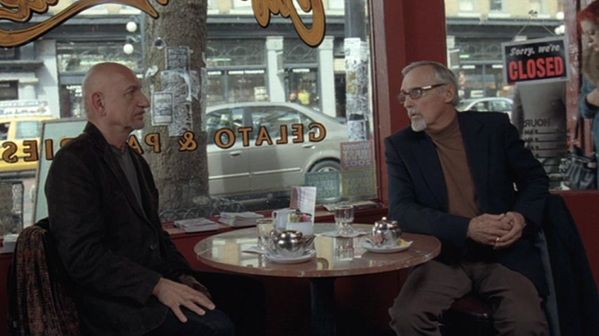
Ben Kingsley and Dennis Hopper in Elegy (Isabelle Coixet - 2008)
Posted by Peter Nellhaus at 08:27 AM
February 03, 2011
From the Thai Film Foundation: Forever Yours

Chuafah Dinsalai
Tawee na Bangchang as "Marut" - 1955
Of the films available on DVD from the Thai Film Foundation, several are from Rattana Pestonji. Forever Yours is the one film from the collection that he produced and photographed, but did not direct. A brief excerpt of this film is included in a scene from Pen-ek Ratanaruang's Last Life in the Universe. Film critic Kong Rithdee provided an overview of Pestonji's contributions to Thai cinema during the centennial commemoration of his birth, three years ago. It is also worth noting that one of the supporting roles was by a young man who later became more noted for his socially conscious writings about Thailand, Rong Wongsawan.
The story is about an older timber magnate, Papo, a widower based in the country. After a reported twenty years of living alone, Papa returns from Bangkok with a young bride, Yupadee. While Yupadee is quite gracious to everyone, she soon has eyes for Papo's nephew, Sangmong. The nephew, tall, with his pompadour adding a few inches, seems oblivious to Yupadee's flirting. The young lunkhead finally gets a clue, and the two start seeing each other secretly, or so they think. Word gets around with Papo's household staff, and the older man, catching the two together, grants the couple their with of being together permanently, by handcuffing them.

What caught my attention was that certain parts of the film document an older way of life. The opening shot is of a train carrying the chopped down trees. Later, we see the work force, men and elephants, pushing the trees to be carried down a river. Papo's factory is contemporary enough, yet his right hand man, Tip, does his accounting with an abacus. Away from the urban, more modern, and unseen Bangkok, Forever Yours takes place in what appears to be a remote part of Thailand where western elements are sparingly integrated into daily life, the most conspicuous of these being the wall clock that indicates the times that the lovers meet, and the piano that provides the song, the theme of the film.
Two brief moments also suggest that some things are virtually axiomatic regarding Thai cinema. During the welcoming party for Yupadee, a man flirts with someone seen only from the back. What appears to be a woman shaking her hips from behind turns out to be an effeminate and mustached man once he turns around. The would be suitor decides to go ahead and dances with his newly found partner. There is also a glimpse of a ghost at the end of Forever Yours. The closing scenes of the film could be used as the basis of something similar to many Thai ghost movies.
Even though the basic story for Forever Yours would appear to be familiar, it goes into a direction not expected and certainly not one that would be found in a traditional Hollywood film. There is also a throwaway moment that might catch a western viewer off guard that suggests that while Papo may not have found someone worthy to be his wife, several of his female household staff had served as mistresses. I don't know if this was part of the novel that served as the basis for the film, but there is an ambiguous mix to the main characters, allowing the viewer to almost simultaneously see the conflicting feelings from differing points of view, rather than have the film dictate the sympathies of the audience.
Forever Yours is also available online from Asia Pacific Films.
Posted by Peter Nellhaus at 08:08 AM | Comments (1)
February 01, 2011
From the Thai Film Foundation: The King of the White Elephant

Phrachao Chang Phueak
Pridi Banomyong - 1941
With the new "For the Love of Film" blogathon coming soon, I thought it appropriate to dedicate most of February to film preservation, and a review of the films available on DVD from the Thai Film Foundation. What I know about Thai culture can pretty much fit into a thimble. Admittedly, my knowledge of Thai film history has huge gaps. Even if what I write is of negligible scholarly value, hopefully some of the screencaps will foster further interest in Thai film and Thai film history. I have to thank Thai film scholar supreme Anchalee Chaiworaporn and the foundation's Chalida Uabunrungjit for making this possible.
Even though Sunh Vasudhara is the director of record, Pridi Banomyong is the person most responsible for the making of The King of the White Elephant. This is the oldest preserved Thai feature, although taken from a 16mm print from the Library of Congress. What makes this film usual is the choice of Pridi to make a nationalistic epic in English. The DVD also contains the American release version which cut the film from 100 minutes down to 52. Because the film was produced with an English language soundtrack, the question is raised concerning whom was the intended audience. At the time the film was made, Thailand was keeping officially neutral in the face of Japan's invasions of other Asian countries.

Political motives aside, it is apparent that Pridi took some of his filmmaking queues from Hollywood films, especially some of the comedies of the era. King Chakra is distracted by affairs of state, not paying attention to the dozens of dancing maidens who have been summoned to entertain, and perhaps be chosen for marriage. A couple of aides to the rival king are seen with their ears against the door, trying to eavesdrop, in a scene that could have been from something by von Sternberg or Lubitsch. There is also some slapstick with the drunken rival king unable to mount his elephant. The film has a similar template to the more recent epics of Yukol Chatrichalerm, with scenes of palace intrigue alternating with battle sequences. There are some spectacular ground level shots of elephants and soldiers marching toward the camera. Some of the shots suggest the possible influence of John Ford. Unintended humor is created by the music track when western classical music is used, especially when "The William Tell Overture", now primarily associated with The Lone Ranger, accompanies footage of the slower moving elephants.
Bosley Crowthers reviewed The King of the White Elephants in April 1941: "Why should a group of Siamese artists attempt to ape Hollywood in a picture about their land? Why should they take a simple story of rivalry between two ancient kings, one a peaceful elephant-lover and the other a martial bully, and dress it up with chases and battles in the manner of an American Western? True, their mounts are pachyderms instead of pintos—and that does make for an interesting variety of spectacle. But why shouldn't a made-in-Siam picture be truly indigenous, played in pantomime, if need be, and as different from Hollywood formula as it could be made?"
The questions of use of language and context are answered by Bangkok Post film critic Kong Rithdee: "The context surrounding the making of that film is different from what we're experiencing now. King of the White Elephant, in which the dialogue is entirely in English, was made specifically to show the international community that Thais are capable of peace and that war, though sometimes inevitable, leaves everybody hurt and in ruins."
One might say that because the film was intended for an international audience, Pridi had chosen to use the most widely accepted model of filmmaking, the Hollywood film, and consequently, the spoken language of Hollywood. The points raised by Crowthers are not invalid, but are addressed more thoroughly in books like Global Art Cinema, even when the discussion is about other films. For all the yelling about making films that are "indigenous" or the effects of cultural imperialism, in order to reach the widest audience, whether locally or internationally, required making a film that generally adheres to Hollwood classical forms. For several reasons, The King of the White Elephant might be regarded as an anomaly in the history of Thai cinema. Where the influence of the film is most obvious is as the template for future Thai films that also looked to the past to address present day concerns.

Posted by Peter Nellhaus at 06:16 AM | Comments (1)
